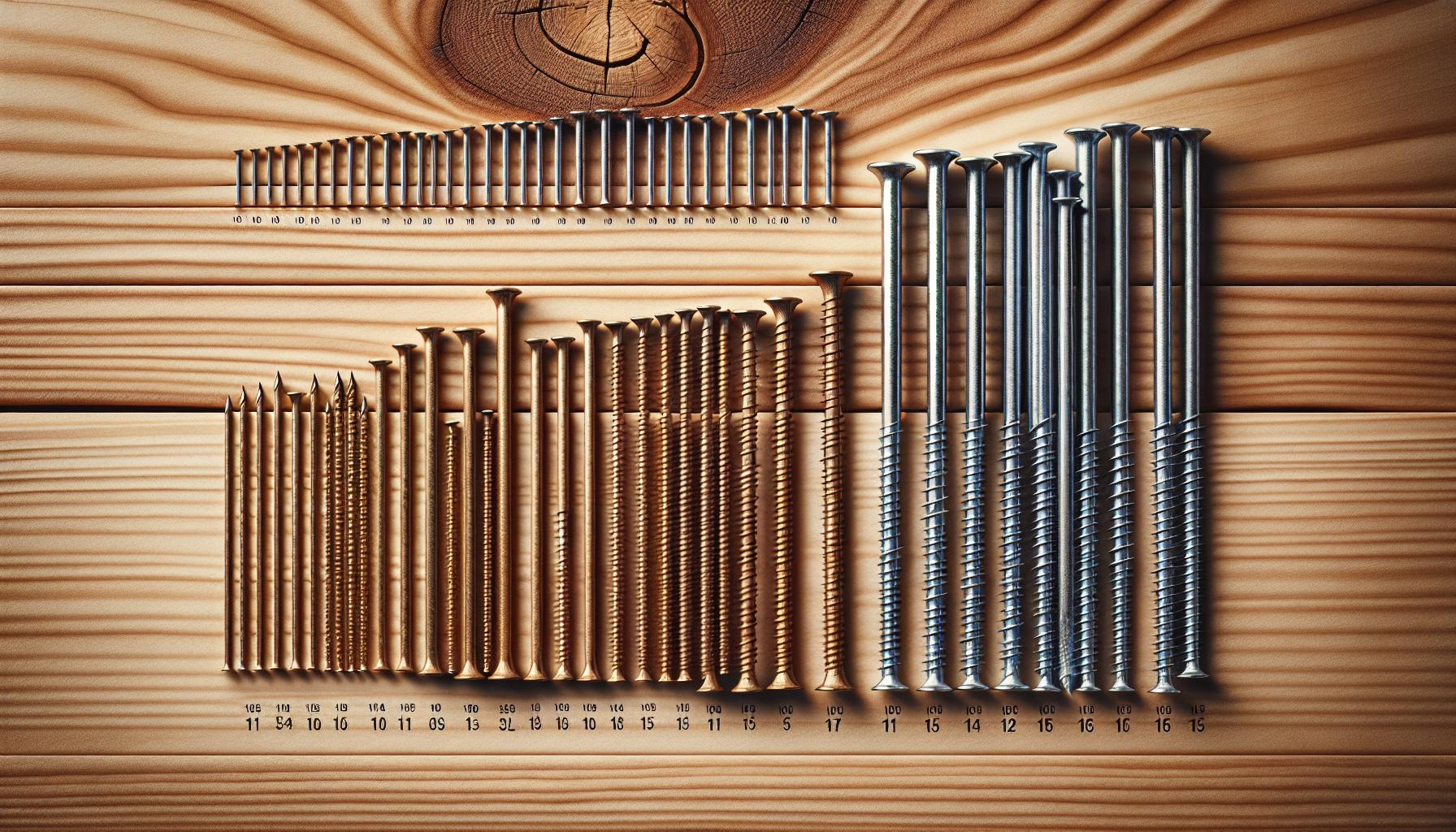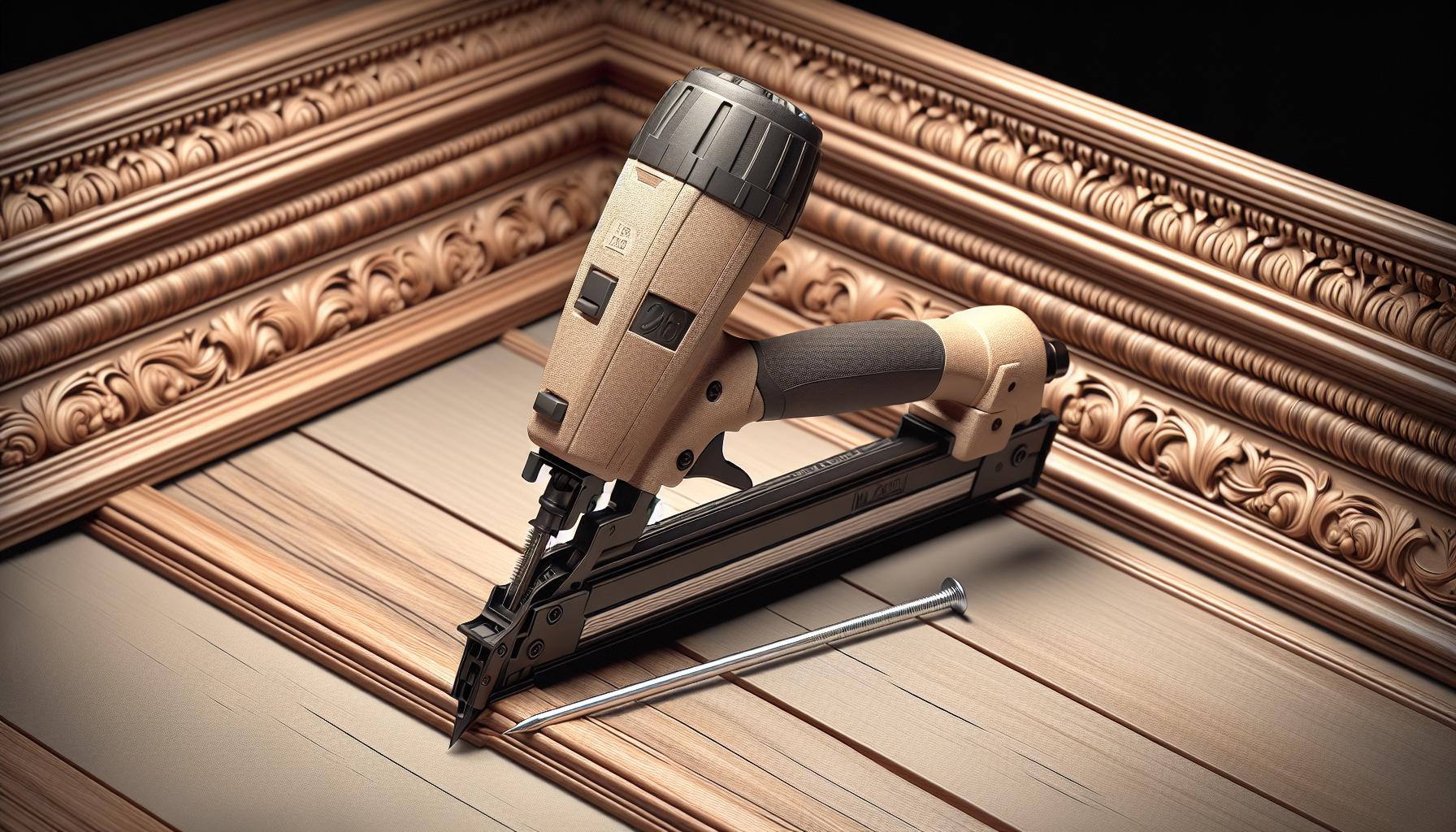When tackling a woodworking project, choosing the right finish nailer is crucial for that perfect finish. I’ve been there, standing in the tool aisle, wondering whether a 15 gauge or 16 gauge nailer is the best fit for my project. It’s a common dilemma for DIY enthusiasts and professionals alike.
The difference between 15 gauge and 16 gauge nailers might seem minute, but it can have a significant impact on the outcome of your work. I’ll break down the essentials, from the size of the nails they drive to the types of projects each is best suited for. Let’s dive into the nitty-gritty of finish nailers and find out which gauge will nail your project’s needs.
What is a finish nailer?
When I’m looking to achieve a polished look on my woodworking projects, a finish nailer is my go-to tool. It’s a type of pneumatic or sometimes cordless nail gun designed for carpentry jobs where I need the nails to be almost invisible. Finish nailers drive thinner nails, compared to other nail guns, which makes them perfect for fine trim work where splitting the wood is a big concern.
These nailers come in various gauge sizes, but we’re focusing here on the 15 gauge and 16 gauge models. The gauge number refers to the diameter of the nail, and the principle to remember is simple: the higher the number, the thinner the nail. A finish nailer typically handles nails that range from about 1 inch to 2.5 inches in length, which provides me with plenty of versatility for different trim and finishing tasks.
Let’s delve into why a finish nailer is a must-have for those delicate jobs:
- Precision: The thin nails provide a clean, precise shot every time, which means less wood filler and sanding later on.
- Hold Strength: Despite their size, these nails offer a strong hold due to their length and how they’re driven into the wood.
- Flexibility: A finish nailer can be used for an array of projects, from baseboards to crown moldings, without worrying about the nails splitting fine pieces.
What sets a finish nailer apart from other nailers is not just the gauge of the nails but also the small head that leaves nearly invisible holes after nailing. This minimizes the need for wood putty to conceal the nail heads, ensuring the final product looks impeccable with minimal touch-up needed. Operating one requires some skill, as the tool’s precision can be a double-edged sword. Proper alignment and nailing technique are crucial, but once mastered, the finish nailer can elevate the quality of any woodworking project significantly.
Understanding gauge in finish nailers
When tackling a woodworking project, one of the crucial decisions I make is selecting the right gauge for my finish nailer. Gauge, essentially, affects the finish nailer’s performance in terms of nail size, holding strength, and the potential for wood splitting. 15 gauge and 16 gauge finish nailers are amongst the most popular choices, but what really is the difference?
The term ‘gauge’ refers to the thickness or diameter of the nails used in the nailers. The higher the gauge number, the thinner the nail. It’s a common misconception to think higher gauge numbers mean thicker nails, but in reality, it’s just the opposite. I’ve compiled a quick overview of the numerical gauge to nail size relationship:
| Gauge Number | Nail Diameter (Inches) |
|---|---|
| 15 Gauge | 0.0720″ |
| 16 Gauge | 0.0625″ |
With a 15 gauge finish nailer, I’m using slightly thicker nails, which offer a stronger hold. This is particularly beneficial for projects where the trim is heavier or requires more support. The larger diameter also means these nailers can typically shoot longer nails, expanding their usefulness for various applications.
On the other hand, a 16 gauge finish nailer works with thinner nails, which are less likely to split delicate trim or smaller pieces of wood. This can be crucial for intricate projects or when working with pre-finished moldings where splits and blemishes can be a significant concern.
One other aspect that I pay attention to is the nail head size. It’s not just the thickness that counts, but also the visibility of the nail after it’s been driven into the wood. While both gauges are designed to leave a clean, nearly invisible hole, the 15 gauge nails have a slightly larger head. This means that they may require a bit more wood putty to conceal if the project demands an immaculate finish.
Understanding the differences between the two gauges has allowed me to make informed decisions based on the project requirements. Whether it’s attaching bulky crown moldings or assembling delicate custom cabinetry, choosing the appropriate gauge ensures a balance between grip and finesse.
Pros and cons of a 15 gauge finish nailer
When it comes to 15 gauge finish nailers, stronger hold is often the first advantage that springs to mind. Given their thicker diameter, these nails provide impressive holding power, making them ideal for heavy-duty tasks. Be it crown molding, staircases, or cabinetry, 15 gauge nails ensure a secure attachment that resists the stresses of everyday use. Furthermore, they’re capable of driving longer nails, which is critical for joining thicker materials without the need for pre-drilling.
Advantages of 15 gauge finish nailers:
- Superior holding strength
- Ability to shoot longer nails
- Ideal for heavier trim and thicker materials
However, the benefits don’t come without drawbacks. The size of 15 gauge nails can potentially lead to a more visible entry point in the wood. This may not be suitable for projects where aesthetic finishing is paramount. Because of their thickness, there’s also a slight chance of wood splitting, especially when dealing with more delicate or thinner wood profiles.
Flipping to the disadvantages, 15 gauge nailers tend to be heavier and bulkier than their 16 gauge counterparts. This might not be a concern for a quick job, but over an extended period, the extra weight could introduce fatigue to your wrists and arms—a point worth considering for professionals who use these tools on a daily basis.
To summarize the cons:
- More visible entry points on wood
- Higher risk of wood splitting on delicate projects
- Heavier weight may cause fatigue over time
It’s clear that my choice between a 15 gauge and a 16 gauge finish nailer hinges on the specific needs of the project at hand. The 15 gauge nailer’s robust nature equips me for tasks demanding endurance and support, while being mindful of its size and the potential impact on the wood’s finish.
Pros and cons of a 16 gauge finish nailer
In woodworking, precision and tool compatibility greatly influence the final product. That’s why it’s crucial to assess the advantages and potential downsides of a 16 gauge finish nailer before making your selection.
16 gauge finish nailers are lauded for their versatility; they straddle the line between fine finish work and more robust applications. They’re lighter in weight compared to their 15 gauge counterparts, which reduces user fatigue and makes them ideal for projects requiring finesse and an extended period of use. This is a significant benefit for DIY enthusiasts and professional carpenters alike who often spend long hours on a job.
Another high point is the nail size. The nails used in a 16 gauge nailer are thinner, which means they leave a smaller entry point in the wood. This is particularly advantageous when working with pre-finished trim or delicate moldings where final appearance is paramount. You’ll find the hole left by a 16 gauge nail to be less noticeable, often negating the need for wood putty or cosmetic touch-ups.
However, it’s not all smooth sailing with 16 gauge finish nailers. While they’re suitable for a range of tasks, they don’t provide the same level of holding power as 15 gauge nailers. This makes them less ideal for installing thick or heavy trim where a more substantial grip is required. The thinner nails can also be a detriment if you’re working with hardwoods or materials that demand a heftier fastener to maintain structural integrity.
The nail length is another aspect to consider. A 16 gauge nailer typically maxes out at shorter lengths than a 15 gauge nailer. This limitation means that when joining or affixing thicker materials, you might not get the depth needed for a secure and lasting hold. It’s crucial to match the tool to the material and project requirements to ensure optimal outcomes.
The 16 gauge finish nailer can be a reliable choice for many, complementing the toolbox with its ability to handle a wide range of woodworking tasks. It’s a tool that offers a balance of ease and subtlety, yet it’s essential to be mindful of its limitations to sidestep frustrations down the line.
Which gauge should you choose?
When deciding between a 15 gauge and a 16 gauge finish nailer, there are several factors to consider. Let’s delve into how to make the best choice for your woodworking needs.
Typically, a 15 gauge finish nailer is my go-to for projects requiring robust joints and the ability to handle substantial trim and moldings. Its nails, being thicker and longer, offer exceptional holding power, making it an excellent choice for staircases, cabinetry, and woodworking tasks where strength is non-negotiable.
On the other hand, the 16 gauge finish nailer strikes a balance between strength and subtlety. I’d recommend it for furniture making or any project where a smaller nail hole may be advantageous. It’s the better option for delicate trims and thinner materials where you don’t want an overly large nail head showing.
To simplify the decision-making process, here’s a quick comparison:
| Feature | 15 Gauge Finish Nailer | 16 Gauge Finish Nailer |
|---|---|---|
| Holding Power | Superior | Adequate |
| Nail Length | Longer Nails | Shorter Nails |
| Material Thickness | Heavier Trim | Lighter Trim |
| Entry Point Size | Larger | Smaller |
If intricate woodwork is your niche, the 16 gauge is the more prudent choice. It leaves behind a less visible entry point, which means less wood filler and a more aesthetically pleasing final piece.
On the counterpart, for projects that encounter heavy use or where structural integrity is primary, I’ll always lean towards a 15 gauge finish nailer due to its unmatched holding power.
Understanding the subtle differences between these nailers is paramount. Always consider the end-use of the project. If precision and a clean finish take precedence, choose a 16 gauge. For jobs demanding solid construction and strength, the 15 gauge is your ally. Remember, matching the correct tool to your material and the project’s requirements is essential for achieving professional results.
Factors to consider when choosing a finish nailer
When deciding between a 15 gauge and a 16 gauge finish nailer, there are several factors to weigh that’ll steer you towards the right choice for your project. I’ve gained insights over the years and I’d like to share a few key considerations that have proven essential.
Project Type
Firstly, the nature of your project is paramount in determining the ideal gauge. If you’re embarking on heavy-duty work like installing baseboards, door casings, or staircase parts, the 15 gauge’s strength is beneficial. For more delicate tasks like assembling cabinets or trim work requiring a fine finish, the 16 gauge’s subtle entry is advantageous.
Material Thickness
With thicker and harder materials, you want a nail that can penetrate deeply and hold fast. A 15 gauge nailer often has the brawn for this. Conversely, if you’re working with thinner, more delicate woods, a 16 gauge reduces the risk of splitting, offering a secure hold without the bulk.
Tool Weight and Size
Don’t overlook the physical attributes of the nailer itself. A heavier nailer can be taxing on your arm during long projects. A 16 gauge nailer is typically lighter and easier to maneuver, which might significantly improve your work experience, particularly in tight spaces or when precision is key.
Hole Visibility
After the nailing is done, you’re often left with the task of filling in the nail holes. If you’re aiming for an unblemished finish, the smaller holes made by a 16 gauge nailer are less conspicuous and simpler to fill, saving you time and effort in post-project clean-up.
Always remember, the ‘right’ tool relies heavily on the task at hand. Each gauge has its merits and by considering the specifics of your work—material, final appearance, and the balance of strength versus finesse—you’ll be well on your way to choosing a finish nailer that aligns perfectly with your woodworking goals.
Conclusion
Deciding between a 15 and a 16 gauge finish nailer can be a pivotal choice in achieving your woodworking goals. I’ve laid out the key considerations to guide you through the decision-making process. Remember, it’s not about one size fits all but about matching the tool to the task. By taking into account the nature of your project and the balance between strength and finesse, you’ll find the nailer that brings your work to its finest finish. Trust in your understanding of these factors and you’ll make the choice that leads to seamless results every time.
Frequently Asked Questions
What is the main difference between a 15 gauge and a 16 gauge finish nailer?
The main difference lies in the diameter of the nails they use. A 15 gauge nailer uses thicker nails than a 16 gauge nailer, which influences the strength of the hold and size of the hole left in the wood.
When should I use a 15 gauge finish nailer?
You should use a 15 gauge finish nailer for thicker, heavier materials or when a stronger hold is necessary. It’s ideal for projects like cabinetry or trim work where the larger head provides a more secure fastening.
Can the weight of the nailer affect my project?
Yes, the tool’s weight can affect user fatigue and precision in handling. A lighter nailer like a 16 gauge may be easier to maneuver for long periods or in tight spaces.
Is hole visibility a major consideration in choosing a nail gauge?
Hole visibility is an important consideration, as it affects the final appearance of your project. A 16 gauge nailer leaves smaller holes that are less visible and easier to fill than those left by a 15 gauge nailer.
How do I decide between strength and finesse when choosing a finish nailer?
Consider the balance between strength and finesse based on your woodworking goals. Use a 15 gauge nailer for maximum strength and holding power, and a 16 gauge for finer finishes where the appearance is more critical and the material is not as thick or heavy.



Reader Interactions